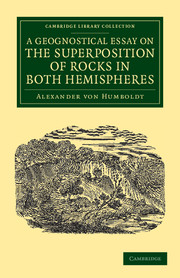
-
Select format
-
- Publisher:
- Cambridge University Press
- Publication date:
- May 2013
- July 2012
- ISBN:
- 9781139226875
- 9781108049498
- Dimensions:
- Weight & Pages:
- Dimensions:
- (216 x 140 mm)
- Weight & Pages:
- 0.62kg, 494 Pages
You may already have access via personal or institutional login
Book description
The explorer and multi-disciplinary scientist Alexander von Humboldt (1769–1859) was a prominent figure in the European scientific community of the eighteenth and nineteenth centuries and the first to make a scientific survey of South and Central America. His travels alone brought him widespread recognition, but the extensive field notes and research he undertook were developed further on his return. Originally published in French and translated in 1823, this work brought his geological speculations to a British audience. Humboldt explores the positioning of different types of rocks across the globe, and the causes behind these formations. He also hypothesises that the flora of these areas are affected by the geology, which in turn is influenced by the thermal currents of the earth's molten core. These insights into rock formations are also key to Humboldt's theory of continental drift, now recognised as resulting from the shifting of the continental plates.
Contents
Metrics
Full text views
Full text views help Loading metrics...
Loading metrics...
* Views captured on Cambridge Core between #date#. This data will be updated every 24 hours.
Usage data cannot currently be displayed.
Accessibility standard: Unknown
Why this information is here
This section outlines the accessibility features of this content - including support for screen readers, full keyboard navigation and high-contrast display options. This may not be relevant for you.
Accessibility Information
Accessibility compliance for the PDF of this book is currently unknown and may be updated in the future.


